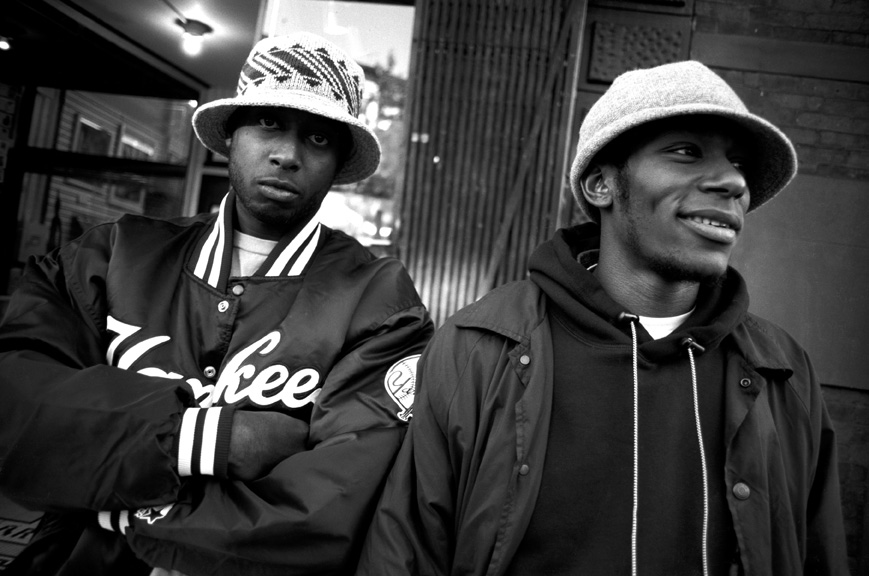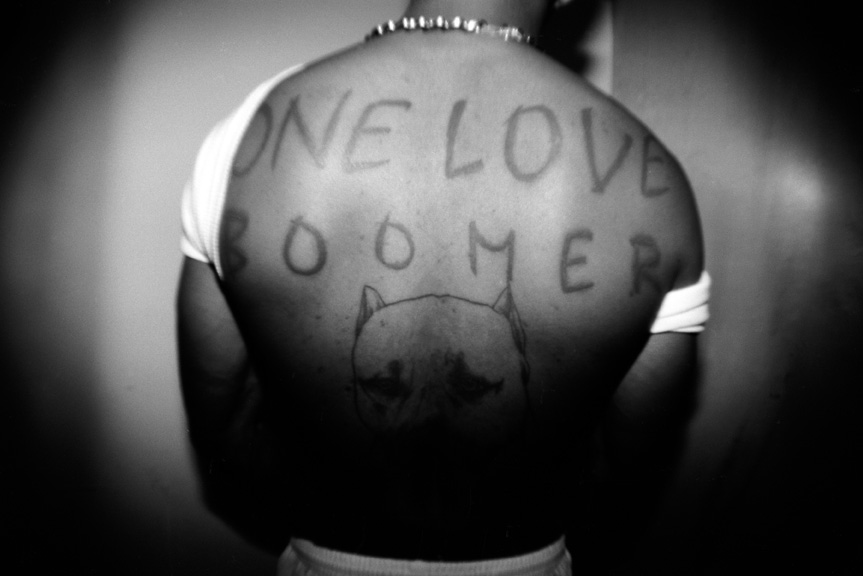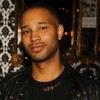Photographer Mike Schreiber's camera must have something magical in it, because it seems like every young MC he shoots turns into hip-hop royalty. His body of work is littered with images of rappers captured right at the tipping point of a legendary career. He's shot nearly every notable rapper, from a young 50 Cent to the late Ol' Dirty Bastard, all frozen in time in his elegant black and white portraits. His images have been gracing the pages of all the major hip-hop publications like the Source and Vibe for years and in 2010 he published the gorgeous photo book True Hip-Hop, which features pictures and stories he's gathered throughout his career.Mike is having his first opening for the book in the NYC area at the powerHouse Arena in DUMBO, Brooklyn, exhibiting 30 powerful prints of icons like Nas and Mos Def. I sat down with the photographer to talk about his life's work, his love of photography, and the time he punked out DMX's posse.VICE: When did you first get your hands on a camera?
Mike Schreiber: My grandfather and my mom were always taking pictures. Even my dad was into photography when he was a kid. When he grew up he had a little darkroom, but he didn’t use it very much. So I can’t remember ever not having a camera, even if it was a Polaroid or a little point-and-shoot. I would love surprising people and taking pictures. I would do stuff like hide in the bathtub and wait for my mom to try take a shower and surprise her by jumping out and taking her photo—this was when I was like five years old.When did you first discover hip-hop?
I was in fifth grade or something. I’m from Long Island, so I didn’t grow up in the city. We heard about it from the news, and movies like Beat Street and Breakin’. I remember I begged my mom to get me this K-Tel record, which was like a compilation. I wanted it because it had like this foldout mat, which you could use to learn how to break dance.Did you get any good?
I never really learned. That was back when “Jam on It” was on the radio all the time.What was “Jam on It”?
You don’t know “Jam on It”? How old are you?I’m 24.
You should still know Jam on It!How does it go?
“Doo, do, doo, do, doo, wiggy wiggy wiggy.”Well, that helps.
Next you’re gonna ask me who Biggie is. [Laughs]You’re book presents some important hip-hop history. Was it always your goal to capture the culture of hip-hop in your photography?
I never really set out to be a “hip-hop photographer,” and even today I don’t consider myself to be that. I graduated from college with a degree in anthropology. I was just hustling, you know?So how’d you get into taking pictures?
I worked at this photo agency that sold syndicated celebrity pictures. I would see photographers come in with these concert photos and it just seemed like such a cool thing to do—much better than sitting in an office. I learned from working there how to get a photo pass. I knew you faxed the publicist and you said who you were working for. So, I made up that I was working for a German magazine, cause I knew they'd never check.What kind of stuff were you shooting?
It wasn’t just hip-hop, it was everything. I remember shooting Lenny Kravitz in like, ’96. But the photographers that shot for the place I worked for started complaining, because they would see me at these shows and thought I was going to sell my pictures. So I got fired from my job. And then I decided I kind of didn’t want to get another job. I wanted to figure out how to make a living doing this.How did you gravitate to documenting hip-hop?
The shows were much more accessible back then. You’d get to know the guys that worked at the clubs so you could get backstage. I would get exclusive stuff and sell it. I made a living doing that for like two years. If I placed two pictures in the Source and three in Vibe, I was good for the month, you know? And from there publicists started to know me and people in the magazines started to know me. I just kind of made the most out of every opportunity, even little opportunities, like the Mos Def picture. Tell me about that one.
Tell me about that one.
Back then I would get real little assignments from the Source. No features or portraits. But then they asked me if I would shoot Black Star in front of Nkiru Books in Brooklyn. So I showed up and nobody was there. Kweli lived like around the corner. When he finally came, he saw that Mos wasn’t there, so he left again. I waited like hours and hours for them to get together.Why didn’t you split?
Well, I didn’t have a job or anything else to do. And it was like my first big opportunity, because nobody had ever asked me to actually shoot something before. Up until then, I was just shooting stuff on my own and then trying to sell it. There are only a handful of photos of Black Star from that time, so it is a good thing that I stuck around for them to finally show up.Tell me about the Lil’ Wayne image.
That was from either 1999 or 2000. The Source sent me out on tour with Cash Money. They were opening for Nelly. At the time, Juvenile was the big draw because of “Back that Azz Up,” and B.G. had “Bling Bling.” This was back when they still had the whole Hot Boy thing together. I was only with them for a couple of shows, in places like Albany and Pittsburgh. It was definitely no Miami. The caliber of groupies was not too high.How did you capture the moment with Weezy?
We were just backstage. It looks like it was probably before the show. He was just chilling with his little Motorola flip phone. Wayne had to have been a teenager at the time.Did you ever catch any Albany groupies from hanging around Wayne and Juvenile?
Who me? No. Who else did you shoot at the very beginning of their career?
Who else did you shoot at the very beginning of their career?
DMX. I shot him when “Where My Dogs At” was just blowing up. It was one of the first things I ever did. I didn’t even have a light meter or know how to use one back then. I didn’t even have an assistant! They told me I had 15 minutes with him. It was at the old Def Jam offices in TriBeCa and everybody was just milling around outside. X must have had half of Yonkers with him.Was the Lox there?
Oh yeah, but back then I didn’t even know who they were. I listened to hip-hop, but we didn’t have cable, so I didn’t know what anyone looked like. I knew the songs, but I didn’t know their faces.So how’d the shoot go down?
Well, everybody was just talking, and I’m hearing the clock ticking. My 15 minutes was gonna be up and I wasn't gonna get shit. So I spoke up real loud and was like, “OK! I need everybody except DMX on this side of the street!” And you could hear a pin drop, because these dudes were real thugs. They all just looked at me like, "What?"Yeah, you fucked up.
Luckily DMX was just like, “No, no. It’s cool! Everybody, it’s cool!” And afterwards the publicist was like “I’ve never heard anybody talk to them like that.” And I was just like this is my chance, this is my opportunity! DMX and I hit it off after that. I ended up just chilling with him all night.Thanks Mike. We'll see you tonight at the opening.True Hip-Hop by Mike Schreiber: Opening & Book Launch
powerHouse Arena
37 Main St.,
DUMBO Brooklyn, NY
6 PM- 9 PM@WilbertLCooper
ΔΙΑΦΗΜΙΣΗ
Mike Schreiber: My grandfather and my mom were always taking pictures. Even my dad was into photography when he was a kid. When he grew up he had a little darkroom, but he didn’t use it very much. So I can’t remember ever not having a camera, even if it was a Polaroid or a little point-and-shoot. I would love surprising people and taking pictures. I would do stuff like hide in the bathtub and wait for my mom to try take a shower and surprise her by jumping out and taking her photo—this was when I was like five years old.When did you first discover hip-hop?
I was in fifth grade or something. I’m from Long Island, so I didn’t grow up in the city. We heard about it from the news, and movies like Beat Street and Breakin’. I remember I begged my mom to get me this K-Tel record, which was like a compilation. I wanted it because it had like this foldout mat, which you could use to learn how to break dance.Did you get any good?
I never really learned. That was back when “Jam on It” was on the radio all the time.What was “Jam on It”?
You don’t know “Jam on It”? How old are you?
ΔΙΑΦΗΜΙΣΗ
You should still know Jam on It!How does it go?
“Doo, do, doo, do, doo, wiggy wiggy wiggy.”Well, that helps.
Next you’re gonna ask me who Biggie is. [Laughs]You’re book presents some important hip-hop history. Was it always your goal to capture the culture of hip-hop in your photography?
I never really set out to be a “hip-hop photographer,” and even today I don’t consider myself to be that. I graduated from college with a degree in anthropology. I was just hustling, you know?So how’d you get into taking pictures?
I worked at this photo agency that sold syndicated celebrity pictures. I would see photographers come in with these concert photos and it just seemed like such a cool thing to do—much better than sitting in an office. I learned from working there how to get a photo pass. I knew you faxed the publicist and you said who you were working for. So, I made up that I was working for a German magazine, cause I knew they'd never check.What kind of stuff were you shooting?
It wasn’t just hip-hop, it was everything. I remember shooting Lenny Kravitz in like, ’96. But the photographers that shot for the place I worked for started complaining, because they would see me at these shows and thought I was going to sell my pictures. So I got fired from my job. And then I decided I kind of didn’t want to get another job. I wanted to figure out how to make a living doing this.
ΔΙΑΦΗΜΙΣΗ
The shows were much more accessible back then. You’d get to know the guys that worked at the clubs so you could get backstage. I would get exclusive stuff and sell it. I made a living doing that for like two years. If I placed two pictures in the Source and three in Vibe, I was good for the month, you know? And from there publicists started to know me and people in the magazines started to know me. I just kind of made the most out of every opportunity, even little opportunities, like the Mos Def picture.

Back then I would get real little assignments from the Source. No features or portraits. But then they asked me if I would shoot Black Star in front of Nkiru Books in Brooklyn. So I showed up and nobody was there. Kweli lived like around the corner. When he finally came, he saw that Mos wasn’t there, so he left again. I waited like hours and hours for them to get together.Why didn’t you split?
Well, I didn’t have a job or anything else to do. And it was like my first big opportunity, because nobody had ever asked me to actually shoot something before. Up until then, I was just shooting stuff on my own and then trying to sell it. There are only a handful of photos of Black Star from that time, so it is a good thing that I stuck around for them to finally show up.Tell me about the Lil’ Wayne image.
That was from either 1999 or 2000. The Source sent me out on tour with Cash Money. They were opening for Nelly. At the time, Juvenile was the big draw because of “Back that Azz Up,” and B.G. had “Bling Bling.” This was back when they still had the whole Hot Boy thing together. I was only with them for a couple of shows, in places like Albany and Pittsburgh. It was definitely no Miami. The caliber of groupies was not too high.
ΔΙΑΦΗΜΙΣΗ
We were just backstage. It looks like it was probably before the show. He was just chilling with his little Motorola flip phone. Wayne had to have been a teenager at the time.Did you ever catch any Albany groupies from hanging around Wayne and Juvenile?
Who me? No.

DMX. I shot him when “Where My Dogs At” was just blowing up. It was one of the first things I ever did. I didn’t even have a light meter or know how to use one back then. I didn’t even have an assistant! They told me I had 15 minutes with him. It was at the old Def Jam offices in TriBeCa and everybody was just milling around outside. X must have had half of Yonkers with him.Was the Lox there?
Oh yeah, but back then I didn’t even know who they were. I listened to hip-hop, but we didn’t have cable, so I didn’t know what anyone looked like. I knew the songs, but I didn’t know their faces.So how’d the shoot go down?
Well, everybody was just talking, and I’m hearing the clock ticking. My 15 minutes was gonna be up and I wasn't gonna get shit. So I spoke up real loud and was like, “OK! I need everybody except DMX on this side of the street!” And you could hear a pin drop, because these dudes were real thugs. They all just looked at me like, "What?"Yeah, you fucked up.
Luckily DMX was just like, “No, no. It’s cool! Everybody, it’s cool!” And afterwards the publicist was like “I’ve never heard anybody talk to them like that.” And I was just like this is my chance, this is my opportunity! DMX and I hit it off after that. I ended up just chilling with him all night.Thanks Mike. We'll see you tonight at the opening.True Hip-Hop by Mike Schreiber: Opening & Book Launch
powerHouse Arena
37 Main St.,
DUMBO Brooklyn, NY
6 PM- 9 PM@WilbertLCooper
